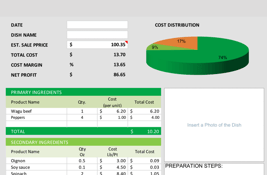A new yet powerful force in the culinary sector is pop-up restaurants.
In search of an inexpensive method to test out fresh menu items and business concepts? Do you want to start your own restaurant but lack the capital to do so?
Perhaps a food truck was the answer for you a few years ago. Not only do they save you money on location, equipment, and labor, but they also allow you to try your hand at cooking and introduce new customers to your food and the teams that make it.
However, pop-up restaurants are a relatively new trend that could be the solution to creating a successful proof of concept because they often don't require using a small vehicle for food preparation, cooking, and serving.
Here are a few things to think about when you're considering starting a pop-up restaurant.
Further reading
What is meant by a pop-up restaurant?
Temporary restaurants known as pop-ups are held in a variety of locations, including bars, theaters, arcades, bowling alleys, and even the homes of chefs.
This type of restaurant can be anything from a food tent at a neighborhood outdoor market that is open for a few months to an exclusive one-night takeover of a nearby restaurant.
Pop-up restaurants are becoming increasingly popular among aspiring and veteran restaurateurs who want to form community ties, generate buzz, and get feedback before investing in a full-fledged restaurant.
In addition, they are an excellent means of initiating connections with the community and forming alliances with neighboring companies.
%20(2).webp?width=800&height=450&name=Eat%20(46)%20(2).webp)
The benefits and drawbacks of starting a pop-up restaurant
Professionals in the restaurant industry are constantly launching new pop-ups, and patrons are lining up to be admitted.
However, before you open one for yourself, you should weigh all the benefits and drawbacks and decide exactly what your goal or aim is.
Successful pop-up restaurants might serve as a source of inspiration for you.
They're [pop-up restaurants] a fantastic way for aspiring restaurateurs to test the waters, for established chefs to flex their creative muscles, and for diners to experience something truly unique and unexpected.
The benefits of starting a pop-up restaurant
- Capacity to assess present abilities and methods and test new restaurant concepts or menus before making additional investments.
- Reduced start-up expenses, such as lower labor and overhead.
- Possibility for inventive cooking.
- If a venue is already established, there is additional marketing power and an existing audience.
- Possibility of testing various pricing strategies, such as prix fixe menus for upscale dining establishments or flat ticket rates.
- Location flexibility and the capacity to transfer concepts or menus between cities.
The drawbacks of starting a pop-up eatery
- Must be prepared to work in an uncharted region, with minimal equipment or resources, or both.
- Despite possibly larger bill averages, it can be challenging to earn a profit due to rising labor and food costs.
- Getting recurring business could be challenging if pop-ups are only sometimes opened.
- Excessive dependence on marketing, public relations, community development, and social media
A complete guide to starting a pop-up restaurant:
Are you inspired to launch a pop-up restaurant now that you've read everything there is to know?
If yes, here are 13 steps to realizing your goal and a handy checklist for starting a restaurant, any restaurant.
1. Decide on a pop-up restaurant design
As previously said, a pop-up restaurant can have several shapes. Here are some ideas for pop-up restaurants for your consideration.
The Blind Pig: This hidden speakeasy in Dublin, Ireland, transports guests back to the Prohibition era with its secret entrance, vintage cocktails, and live jazz music.
Dinner in the Sky: This global pop-up experience takes diners to new heights, literally, by raising them 150 feet in the air for a multi-course meal with breathtaking views.
The Coop: This London-based concept transforms rooftops into urban farms and chicken coops, serving fresh, farm-to-table meals alongside stunning cityscapes.
Sushi on a Bullet Train: This unique pop-up in Japan offered high-speed sushi deliveries directly to passengers' seats on a bullet train, combining travel and gourmet dining in a novel way.
Cloud Cuckoo Land: This immersive, theatrical dining experience in London takes guests on a multi-sensory journey through different chapters of a fantastical story, complete with elaborate sets, costumes, and interactive performances.
Le Petit Plongeoir: This pop-up restaurant in France takes the plunge by setting up shop in a swimming pool, offering diners a refreshing and unique dining experience surrounded by water.
%20(1).webp?width=800&height=450&name=Eat%20(48)%20(1).webp)
2. Write a business plan for a pop-up restaurant
Creating a business plan is the next stage in establishing any venture after you have your concept secured.
Your pop-up restaurant business plan will serve as a guide that details every aspect of your concept, including the pop-up's ultimate objective.
When you're lost in the details, the plan will serve as a guide to help you stay on task.
You will discuss your business overview and activities here, including who your suppliers are. What is your service and staffing model?), along with any information that will assist you get things underway.
Start writing your business plan for a pop-up restaurant right now.
Free Restaurant Business Plan Template
3. Select a place for the pop-up restaurant
For obvious reasons, it is easier to take over an existing pop-up restaurant or one that is about to close.
Regularly rotating pop-up markets are also excellent places to check out.
If you're just starting, though, look into local bars and restaurants that regularly host pop-ups, or come up with unusual locations for your pop-up restaurant, such as arcades or bowling alleys.
%20(1).webp?width=800&height=450&name=Eat%20(49)%20(1).webp)
Here are some things to think about while picking the ideal site for your pop-up restaurant:
- Is Rustic Your Style? Trendy? Classy? friendly to families? Lighthearted? This can help you figure out who your target market is.
- Target Audience: People are drawn to different parts of your city for different reasons. If you want to draw in tourists, families, young professionals, or students, think about it and modify your schedule to coincide with their usual locations.
- Parking and accessibility: If you're drawing in tourists, parking shouldn't be an issue because most of them will take public transportation or rideshare. Parking shouldn't be a deal-breaker if you're in a pedestrian-friendly region. In the suburbs, though? It will be important.
- Restrictions: Can a pop-up restaurant be opened here given the zoning restrictions?
- Will the kind of consumers you're going to attract allow you to offset the cost of rent and utilities?
Further reading
4. Research the licenses, permissions, and legal requirements for pop-up restaurants
It’s wise to start with state-specific requirements when obtaining the licenses and permits required to launch a pop-up.
Getting permits to create a new business is subject to state and local laws in many cases, so you should begin the process of securing them as soon as feasible.
Begin this phase by determining which licenses and permits your restaurant will require between now and opening day.
Check out your local regulations and compile a comprehensive list, as some forms require the fulfillment of other permits. To ensure that you don't overlook anything, list all the tasks that must be completed in the correct order.
The following licenses and permits, among others, can be required to launch a pop-up:
- Sales authorization
- Alcohol license
- Zoning regulations
- A license to handle food
- License for catering
- Inspection of health and safety
5. Gather the tax, DBA, and EIN data for your mobile eatery company
States differ in the tax and employment criteria that must be met to create a pop-up restaurant, in addition to the licensing and permission procedures for restaurants.
Likewise, to prevent missing deadlines, it's a good idea to begin this process as soon as possible.
New businesses need to comprehend restaurant tax rules to stay out of trouble.
Obtain the required tax documentation from an internal or external tax expert. Next, if appropriate, register for your DBA (Doing Business As), which is another moniker for your distinct trade name.
Then, to file income and payroll tax forms, you'll require an EIN (Employer Identification Number) if you intend to recruit staff.
These are only a handful of the fundamental regulatory procedures that you must adhere to; as with licenses and permits, do your research online to determine the specific requirements in your state and county, as well as seek advice from an expert.
Comment
by from discussion
insmallbusiness
6. Create a branding, marketing, promotion, and advertising plan for your pop-up restaurant
Prepare for success with your big opening by using effective marketing to draw clients in.
Making a restaurant marketing strategy is the ideal place to start since it allows you to decide which best practices to implement, create targets, and organize your marketing schedule and budget for that crucial first year.
Identifying precisely what you are marketing is the first step in creating a marketing strategy.
Your branding—the overall appearance and feel of your restaurant, website, plating, and social media—will be determined by the unique offering of your pop-up restaurant and the target market.
Your target customer, the platforms they use online and on social media, whether you want to pay to enhance social media ads, and other factors should all be taken into account when choosing your marketing and advertising strategy.
You should also think about where your one-time customers typically hang out.
Creating a compelling social media marketing plan for your restaurant can assist in presenting your food in an eye-catching and easily shared manner when you open for business.
Social media plays a crucial role in promoting pop-up restaurants and drawing in new clientele.
The Restaurant Marketing Plan template from Eat App can also be used to create a strategy for drawing customers in and encouraging them to return.
And have a spectacular opening to kick off your pop-up restaurant's successful launch.
These are some suggestions to get you going and create some initial excitement for your pop-up restaurant.
7. Determine the running costs, sales projections, and financial status of your pop-up restaurant
Now that you have a better understanding of your pop-up restaurant's finances, it's time to go back over your restaurant business plan and schedule daily operational costs.
Gaining a deeper comprehension of your marketing and operating expenses will help you forecast future profits more precisely.
What is the startup cost of a pop-up restaurant?
The total cost of starting a pop-up restaurant is generally cheaper than that of a regular permanent business, with fewer initial investment expenditures, though there is no predetermined figure.
What is the cost of operating a pop-up?
The costs of operating a pop-up restaurant should be considered when accounting for things like staff, marketing, building, technology, and food.
Typical operating costs for a restaurant include rent, utilities, labor, technology, inventory, permits, and equipment and appliances.
The precise prices will depend on your location and the terms of your business agreements; if you are renting space in a food hall or market, some of these expenses may already be covered by your rent.
Further reading
8. Obtain financing and funds for pop-up restaurants
Most people don't have the money on hand to launch a new company right now. Fortunately, financing for restaurants is available, and there are several possibilities to take into account.
Are you trying to come up with a cashless pop-up restaurant idea?
Among many other choices, look into how to obtain a business line of credit, an SBA Microloan for small businesses, a new business grant, or finance for the equipment needed for the pop-up restaurant kitchen.
Once you have the funding, you may begin purchasing equipment and furnishing your workspace with the necessities.
9. Create a menu for your temporary restaurant
Take advantage of the chance to create a menu for your pop-up restaurant that will surprise and excite new customers.
Whether your menu is item-by-item or prix fixe, be sure to include the cost of the prime and food to ensure you're making a profit.
Starting with your unique concept, create a menu for your pop-up restaurant. Do you have a comprehensive menu of foods? A menu of little bites? Adapting each day? Now is the moment to solve the puzzle.
To begin, just jot down all of your ideas, then group them according to the ingredients and resources required. Examine what your rivals are offering to determine where you might capitalize on trends in the industry or close a gap in the market.
Then, create a pop-up restaurant menu that will increase sales and attract new customers by using menu design techniques and menu engineering.
Further reading
10. Locate your source of pop-up restaurant inventory
You can now start buying your inventory after deciding on your menu items and the supplies and ingredients you'll need to prepare them.
Naturally, you must first determine where you will get your goods. It's a good idea to spend your time researching possible vendors by reading reviews and speaking with peers.
Pop-ups may find it difficult to overcome supplier delays and misunderstandings, particularly in the early stages of their business. Collaborate with a reputable and trustworthy supplier to steer clear of inventory issues.
You can utilize a variety of wholesale systems for the food sector to manage your inventory. Additionally, you should be able to locate a variety of nearby businesses where you can buy your goods, depending on where you live.
Further reading
11. Invest in a point-of-sale system for pop-up restaurants
Selecting a point-of-sale system is another necessary choice you'll need to make for how your shop will run.
The most effective point-of-sale (POS) systems for startups facilitate seamless payment processing for both employees and visitors.
If you want to eventually turn your pop-up restaurant into a full-fledged restaurant enterprise, be sure to work with a restaurant POS system that can expand with you.
Point-of-sale systems accomplish this while also giving you access to reports and analytics that enable you to monitor the success and well-being of your company.
Pop-ups benefit from restaurant point-of-sale software capabilities such as:
Simple interface: Big buttons and an intuitive user interface can shorten wait times on busy weekends and expedite order turnaround times.
Handheld gadgets: To accept payments from customers and sell goods from any location, mobile pop-up restaurants require handheld point-of-sale (POS) equipment.
Further reading
12. Create the ambiance and style of your pop-up restaurant
You will now need to create a layout and environment for your pop-up restaurant that will support your business objectives after creating a comprehensive restaurant business plan and vision.
Your service manner should mirror the mood you want to create, and the decor should complement the cuisine and your concept.
This can be rather simple (you might be able to use the dining area of the restaurant you've partnered with), depending on your pop-up concept and location, or it can be a little difficult (depending on space and resources).
Look through these sample restaurant layouts for design ideas.
13. Assign personnel and management to your pop-up restaurant
A successful restaurant is built on its workers. You can start by reaching out to your network, past coworkers, and local industry Facebook groups when hiring for a pop-up restaurant or any other type of business.
Moreover, you can check out job sites such as Sirvo, Snagajob, Poached, Jobs On The Menu, Restaurant Zone, and Culinary Agents.
Further reading
Takeaways
Although starting a new pop-up restaurant can be difficult, it can be made easier by completing your homework and approaching the process step by step.
Perhaps you will enjoy the freedom of operating a pop-up store, or perhaps one day your pop-up will become a brick and mortar.














.webp?width=200&name=v2-15mknc-qpw1b%20(1).webp)
.webp?width=200&name=v2-15kqni-p0exl%20(1).webp)
-1.png?width=1812&height=1072&name=TripAdvisor%20%26%20More%20Bookings%20(1)-1.png)
-2.png?width=1812&height=1072&name=Google%20Bookings%20(1)-2.png)


-1.png?width=200&name=TripAdvisor%20%26%20More%20Bookings%20(1)-1.png)
-2.png?width=200&name=Google%20Bookings%20(1)-2.png)
-1.png?width=200&name=Instagram%20Bookings%20(1)-1.png)
-1-png.webp?width=200&name=Facebook%20Integration%20Rectangle%20(1)-1-png.webp)







.webp?width=200&name=download%20(1).webp)
%20(1)-2.webp?width=200&name=Eat%20(34)%20(1)-2.webp)
%20(1)-2.webp?width=200&name=Eat%20(18)%20(1)-2.webp)




%20(2).webp?width=670&height=440&name=Eat%20(46)%20(2).webp)



%20(1)-1.webp?width=314&height=175&name=Eat%20(62)%20(1)-1.webp)


.webp?width=144&height=72&name=Eat%20App%20Logo%20(3).webp)